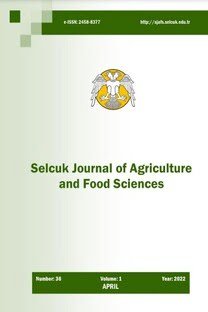Broyler rasyonlarına ilave edilen çinko-metiyonin ve çinko-lizinin besi performansı, karkas özellikleri, karaciğer ve plazma çinko konsantrasyonuna etkileri
Bu çalışma, farklı seviyelerde çinko-metiyonin (ZnM) ve çinko-lizin (ZnL) ihtiva eden rasyonlann broylerlerde besi performansı, karkas karakterleri, karaciğer ve plazma Zn konsantrasyonuna etkisini tespit etmek maksadıyla yapılmıştır. Denemede 4 farklı ZnM $(M_0, M_1, M_2, M_3)$ ve 4 farklı ZnL $(L_0, L_1, L_2, L_3)$ seviyeleri ile bunların kombinasyonlarından oluşan 16 muamelenin etkisi araştırılmıştır. Deneme 42 gün sürmüş ve hayvanlar deneme boyunca ad libitum olarak yenilenmiştir. Rasyon ZnM, ZnL seviyeleri ve bunların farklı kombinasyonları hayvanların deneme boyunca canlı ağırlıklarını (CA) ve 5.hafta hariç diğer haftalarda canlı ağırlık artışlarını (CAA) önemli derecede etkilememiştir (P>0.05). Rasyon ZnM, ZnL seviyeleri ve interaksiyonlar, deneme hayvanlarının 1, 2., 5.ve 6.haftalardaki yem tüketimlerini (YT) önemli derecede etkilememiştir (PX).05). Ancak rasyon ZnL seviyesi 3., 4.ve 0-6.haftalardaki YT'ıü önemli derecede etkilemiştir (P
Effects of adding zinc-methionine and zinc-lysine to broiler ration on fattening performance, carcass characteristics and liver and plasma zinc concentration of broilers
This study was carried out to determine the effects of diets containing different levels of zinc-methionine (ZnM) and zinc-lysine (ZnL) on fattening performance, carcass characteristics and liver and plasma Zn concentration of broilers. In this study 1280 one day old Avian Farmt type broiler chicks were fed four levels of ZnM $(M_0, M_1, M_2, M_3)$ and four levels of ZnL $(L_0, L_1, L_2, L_3)$ in factorial arrangement for 42 days. Feed and water were given as ad libitum. Dietary ZnM and ZnL levels and ZnM*ZnL combinations produced no significant effect on weekly live weight(LW) and live weight gain(LWG) during the 42 .days experiment(P> 0.05), except on 5th week LWG. Ration ZnL level had a significant effect on LWG at 5th week of the experiment(P< 0.05). The ration ZnM, ZnL levels and ZnM*ZnL interactions were not significantly effect the feed consumption (FC) at the 1th, 2nd, 5th and 6th weeks of the experiment(P>0.05). However, ZnL level had a significant effect on FC at the 3th (P<0.01), 4th (P<0.05) weeks and cumulative (PO.05), and ZnM*ZnL interactions had a significant effect on FC at the 3th week (PO.05) of the experiment. The ration ZnM, ZnL levels and ZnM*ZnL interactions did not have a significant effect on feed efficiency (FE) at the 1*, 2nd, 4nd , 6th weeks and cumulative (P>0.05). However, ZnL level had a significant effect on FE at the 3th and 5th weeks(P<0.05) of the experiment. The ration ZnM, ZnL levels and ZnM*ZnL interactions produced no significant effect on dressing percentage, wiiig and rump weights at the end of the experiment (P>0.05). However, dietary ZnM level had a significant effect on carcass weight (P<0.05), neck weight (P<0.01), breast and abdominal fat weight, at the same time breast and abdominal fat weight were effected by dietary ZnL level, significantly(P<0.05) and ZnM*ZnL interactions had significant effect on breast weight (P<0.05) at the end of the experiment Dietary ZnM, ZnL levels and ZnM*ZnL interactions had no significant effect on liver zinc conceîitration(P<0.05). However, ZnL level had significant effect on plasma zinc concentration(P<0.05), other treatments had no significant effect on this parameter.
